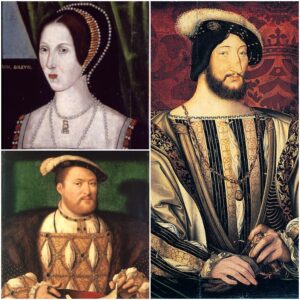 At just before dawn on this day in history, 11th October 1532, Anne Boleyn, the newly created Marquess of Pembroke, and her sweetheart, King Henry VIII, set sail from Dover in the king’s ship, The Swallow.
At just before dawn on this day in history, 11th October 1532, Anne Boleyn, the newly created Marquess of Pembroke, and her sweetheart, King Henry VIII, set sail from Dover in the king’s ship, The Swallow.
They were headed for Calais, which was an English territory at the time. The purpose of their trip was to meet with King Francis I of France and gain his support for their relationship and their quest for the annulment of Henry VIII’s marriage to Catherine of Aragon.
They landed at Calais, at 10 o’clock the same morning and were greeted by a “greate peale of gonnes” and a procession, which included the Mayor of Calais, the Lord Deputy and various knights. Henry and Anne then went to hear mass at the Church of St Nicholas before retiring to their lodgings at The Exchequer.
The couple stayed together there until 21st October, when Henry left Anne to meet Francis I. After a few days with the French king, Henry brought Francis back to Calais to meet Anne. Here is a timeline of the events of October and November 1532 with clickable links to find out more.
- Friday 11 October 1532 – Henry VIII and Anne Boleyn set sail. At dawn on 11th October, Henry and Anne set sail from Dover on The Swallow and arrived at Calais at 10 o’clock in the morning.
- Wednesday 16 October 1532 – The Meeting with the Great Mayster of Fraunce. While Anne Boleyn and Henry VIII were lodged in Calais, the Duke of Norfolk, Earl of Derby and a group of gentleman met with “the great mayster of Fraunce” Anne, duc de Montmorency, and his men at the English Pale, six miles outside of Calais.
- Monday 21 October 1532 – Henry VIII meets up with Francis I. Henry VIII left Anne Boleyn in Calais to spend four days with Francis I, “his beloved brother”, at the French court in Boulogne.
- Friday 25 October 1532 – Francis I makes Norfolk and Suffolk Knights of the Order of St Michel, the French equivalent of the Order of the Garter.
- Friday 25 October 1532 – Henry VIII and Francis I arrive at Calais. On 25th October, Henry VIII and Francis I left Boulogne, where Henry VIII had been Francis’s guest at the French court, to go to Calais and there meet with Anne Boleyn, Marquis of Pembroke. On arrival at Calais, Francis I sent Anne Boleyn a diamond via the Provost of Paris.
- Sunday 27 October 1532 – Anne Boleyn makes a dramatic entrance. Anne Boleyn made a dramatic entrance at the banquet held by Henry VIII in Francis I’s honour at Calais.
- Monday 28 October 1532 – Henry and Anne’s Last Full Day in Calais with Francis I. There was a chapter of the Order of the Garter, where Henry VIII made Anne, duc de Montmorency and Grand Master of France, and Philippe de Chabot, Admiral of France, Knights of the Garter.
- Tuesday 29 October 1532 – Henry VIII says Goodbye to Francis I.
- Tuesday 29 October to 10 November 1532 – Storms delay departure.
- Sunday 10 November 1532 – Henry VIII’s bed and baggage were loaded ready for departure, but departure was delayed by fog.
- Tuesday 12 November 1532 – Henry VIII and Anne Boleyn Set Sail for Dover. At midnight on Tuesday 12th November 1532, King Henry VIII and Anne Boleyn set sail from Calais bound for the Kent port of Dover.
- Thursday 14 November 1532 – Henry VIII and Anne Boleyn landed at Dover, on the Kent coast, at 5am.
- Thursday 14 November 1532 – The Marriage of Henry VIII and Anne Boleyn? Chronicler Edward Hall records a marriage ceremony between Henry and Anne on 14th November 1532, St Erkenwald’s Day.
- Sunday 24 November 1532 – The couple arrive back in London at Eltham Palace. Eustace Chapuys, imperial ambassador, recorded that the King spent a few days in Dover and the surrounding area “for the purpose of having harbours constructed in the said town, or at least of creating a spacious plea for asking money from his subjects for the said works”.
Also on this day in history, 11th October 1537, poor Jane Seymour was in labour with her first and only child, Edward VI:
Today, is also the anniversary of the death of Sir Thomas Wyatt the Elder, Tudor poet and diplomat, on 11th October 1542. You can find out more about him in my article – click here.